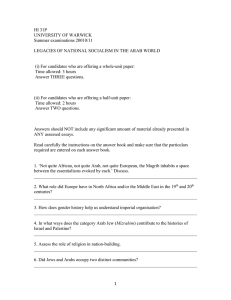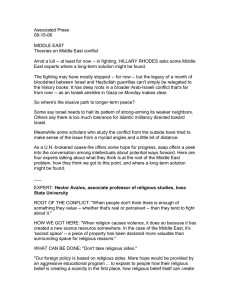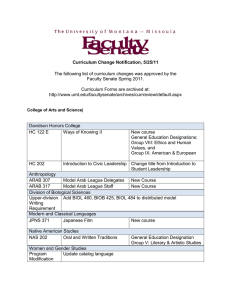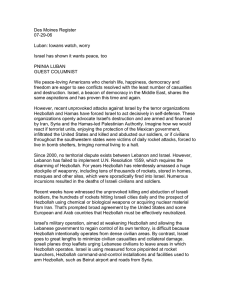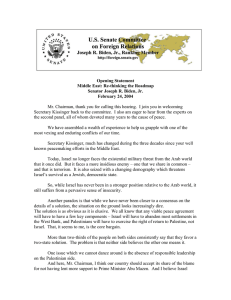The Sixth Arab-Israeli War: An Arab Perspective
advertisement
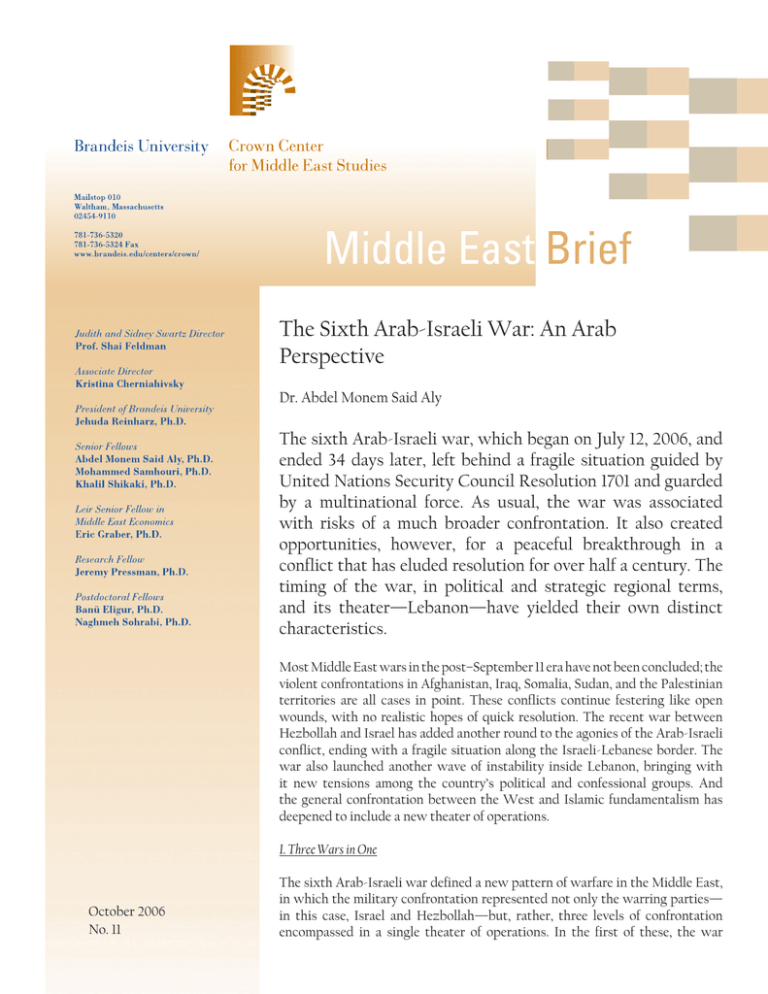
The Sixth Arab-Israeli War: An Arab Perspective Dr. Abdel Monem Said Aly The sixth Arab-Israeli war, which began on July 12, 2006, and ended 34 days later, left behind a fragile situation guided by United Nations Security Council Resolution 1701 and guarded by a multinational force. As usual, the war was associated with risks of a much broader confrontation. It also created opportunities, however, for a peaceful breakthrough in a conflict that has eluded resolution for over half a century. The timing of the war, in political and strategic regional terms, and its theater—Lebanon—have yielded their own distinct characteristics. Most Middle East wars in the post–September 11 era have not been concluded; the violent confrontations in Afghanistan, Iraq, Somalia, Sudan, and the Palestinian territories are all cases in point. These conflicts continue festering like open wounds, with no realistic hopes of quick resolution. The recent war between Hezbollah and Israel has added another round to the agonies of the Arab-Israeli conflict, ending with a fragile situation along the Israeli-Lebanese border. The war also launched another wave of instability inside Lebanon, bringing with it new tensions among the country’s political and confessional groups. And the general confrontation between the West and Islamic fundamentalism has deepened to include a new theater of operations. I. Three Wars in One October 2006 No. 11 The sixth Arab-Israeli war defined a new pattern of warfare in the Middle East, in which the military confrontation represented not only the warring parties— in this case, Israel and Hezbollah—but, rather, three levels of confrontation encompassed in a single theater of operations. In the first of these, the war constituted another episode of the Arab–Israeli conflict. It reflected the general law of Arab-Israeli politics: that unless progress is made in Arab-Israeli peacemaking, violence in one manner or another will eventually erupt. And since no progress in regional peacemaking had been made since the failure of the summer 2000 Camp David talks and the subsequent introduction of the Clinton parameters in December of that year, violence was inevitable. The post–September 11 world made the vacuum in peacemaking all the more pronounced. Attempts at breakthroughs in the Palestinian-Israeli conflict through the Bush Initiative, the Road Map, and the Quartet have all failed to become serious political and diplomatic efforts, as opposed to superficial displays of attention to the conflict. The increasing problems confronting the Bush administration—its failures in Iraq and in the war on terror—have sealed the fate of Arab-Israeli peace efforts. The predictable violence resulting from the vacuum took several forms. The Palestinian second Intifada was the first response, leading eventually to the success of Hamas in the Palestinian elections. The aftermath of the Camp David failure then witnessed a number of mini Palestinian-Israeli wars, the most recent of which began on June 25, 2006, after the kidnapping of an Israeli soldier from an Israel Defense Forces (IDF) base inside Israeli territory. The war in Lebanon was only the most recent contribution to the filling of the same vacuum. And while this episode has ended, the war has not. Abdel Monem Said Aly is Director of the Al Ahram Center for Political & Strategic Studies, Cairo, Egypt and a Senior Fellow at the Crown Center for Middle East Studies, Brandeis University. This same war was also an expression of Lebanese domestic politics and an extension of the Lebanese civil war. The Taif Agreement that formally ended the Lebanese civil war in 1989 had stipulated the disarming of all Lebanese militias; subsequently, all these militias disarmed with the exception of Hezbollah, which not only remained armed but also maintained a monopoly of force in all of South Lebanon and in parts of Beirut. The withdrawal of Syrian forces from Lebanon on April 26, 2005, following the Cedar Revolution encouraged Lebanese political forces to demand Hezbollah’s disarmament through the so-called “national dialogue.” The balance of power in Lebanese politics changed after the Syrians withdrew, and Hezbollah apparently thought that nothing would restore the balance better than a war with Israel. The Lebanese people were thus presented with an unpalatable choice: a war with Israel or another bloody civil war. A third context in which the recent war should be understood is as part of the broader U.S. war on terror—or, even more generally, on fundamentalist Islam. The post– September 11 war on terror has expanded from Afghanistan to Iraq, Iran, Syria, and the Palestinian territories—even to the shores of the Philippines. And the counteroffensive waged against the United States now includes the resurgence of the Taliban in Afghanistan, the nuclearization of Iran, the fundamentalist resistance and terror in Iraq, the winning of elections by Hamas in Palestine and by the Muslim Brothers in Egypt, the triumph of the Sharia courts in Somalia, and the resurgence of al-Qaeda terror types and groups in Egypt and Algeria. The war launched by Hezbollah on July 12 and its subsequent perceived victory were part of this counter-offensive. Thus, for all practical purposes the recent war between Hezbollah and Israel constituted “three wars in one.” The Arab-Israeli dimension of the war was not different in kind from other episodes in the historical sequence of wars that have marked this conflict over the past six decades. The Lebanese civil war is basically local, similar to those in Somalia and Sudan. By contrast, it was the global dimension of the recent war that made it central to the conduct of regional politics and international relations. Moreover, the basic issues involved in each of the three dimensions of the recent Hezbollah-Israel war are very different. At the heart of the Arab-Israeli conflict are the prospective terms of peacemaking. On the Lebanese domestic front, the basic issue is the future of the Lebanese state, and the issue of “the state” in the Middle East at large. On the global level, however, the major issue concerns the best manner of dealing with radical and fundamentalist Islam. Thus, while the three wars are related geographically and historically, in diplomatic and political terms they have very different implications, and they have produced quite distinct results. II. The Arab Debate With this reality of “three wars in one” in mind, the debate that ensued in both Israeli and Arab politics and media about who won the recent war seems largely irrelevant. The war constituted merely one battle in a continual conflict in which concepts of “victory” and “defeat” not only are misleading but are harmful for policy purposes. Indeed, viewing the war from this perspective raises more questions than it provides answers. Nevertheless, this seems to have been the prevailing pastime of analysts during the five weeks of fighting and in the war’s immediate aftermath.1 In Israel, viewing the war in winners-and-losers terms was part of the democratic process, coupled with the effects of the “new media.” In the Arab world, it was part of the mobilization efforts of the various political systems, fueled by the new Arab media. Never in the history of the ArabIsraeli conflict had the Arab media quoted the Israeli press with such frequency. In this context, Israel was at a serious disadvantage because it could not affect the media output: It lost the “war of the narratives” not because it lost the war, but because it won it in a manner that was slower and less decisive than anticipated. In the long run, however, the failure of the Arab side, in this case Hezbollah, to conduct the kind of self-examination exercised in Israel in the aftermath of the war will lead it to new defeats. The debates in the Arab world during and immediately after the war about “victors” and “vanquished” reflected a failure to look at the unfolding global, regional, and domestic developments as part of one complex historical process. One faction of Arab media celebrated the historical defeat of the Israel Defense Forces, Hezbollah’s supposed success in changing the Middle East balance of power, and Hassan Nasrallah’s restoration of “Arab dignity” by “teaching the Israelis the lesson of their life.” By contrast, a second faction pointed its fingers precisely at those whom the first faction declared to be “victors.” This second faction argued that Hezbollah failed to change Israeli policy, fell short of providing any form of security to Lebanon and its citizens, and should be held accountable for the huge bill that Lebanon would have to pay in the war’s aftermath. Later, following the adoption of UNSC Resolution 1701 and as the arguments over “victory” and “defeat” became less pronounced, a third faction appeared in the Arab media, denying victory to both sides on several grounds. In evaluating this debate, three questions need to be addressed. First, what were the arguments presented by each of these factions? Second, why was there such confusion over an issue that would not have been a subject of debate in the 1960s and 1970s? And finally, what does this confusion imply, and what conclusions can be drawn from such divergent Arab perceptions of the recent war? From the outset of the war, opinion in the Arab media varied between support for Hezbollah and condemnations of its behavior as irresponsible and as having led to a deteriorated state of security in Lebanon. The voice of the Arab street, however was clear in supporting Nasrallah and his militia. As soon as the war broke out, protests shook Arab streets, with Hezbollah banners held high. Islamic sentiments were mobilized for the struggle with Israel and became a rallying cry in support of Hezbollah. Some newspapers distributed free posters of Nasrallah, depicting him as “the symbol of resistance,” and bumper stickers with his picture began to appear on cars roaming Arab streets. Moreover, as soon as UNSC resolution 1701 was adopted and the cease-fire began to be implemented, Arab newspapers and television channels became even more excited—and celebratory with respect to the “victorious” Arab militia. For example, the Egyptian newspaper Al-Ahram headlined a story “Hezbollah Confrontation: The Biggest Failure in Israeli War History,”2 and Nawaf Al-Zaro, a writer for the Al-Jazeera website, opined that “the military, political and security institutions in Israel went into a phase of internal imbalance in the heels of the total defeat that Israel has suffered in the last Lebanon war.”3 Similarly, Habib AlMekany, a writer for the Tunisian newspaper Al-Wasat, wrote that “Hassan Nasrallah has bitterly ended the myth of the Israeli army after shaking the pillars of Israeli national security.”4 And Abdallah Al-Sannawi, editor in chief of the Egyptian Nasserite party newspaper Al-Araby, wrote that “all the signs and evidence point to Israel’s utter defeat.”5 Perhaps the most pronounced expression of this school of thought could be found on the pages of Al-Wafd, an Egyptian newspaper of the Wafd party. The newspaper’s front page displayed a picture of Israeli prime minister Ehud Olmert, his face bent, with one caption in Arabic reading “the end of the myth” and another, in English, reading “The End.”6 The arguments supporting the idea of a victorious Hezbollah had a common, reiterated theme: The movement survived the IDF’s attack and was able to continue hitting Israeli civilian targets until the end of the fighting. The main point was Israel’s failure, despite its supreme military capability, to abolish an entity like Hezbollah. Nasrallah’s personal survival was itself a focal point in these arguments, which portrayed the war as a failed Israeli manhunt for the movement’s leader. The fact that the war did not end in Hezbollah’s being compelled to disarm was another dimension of this narrative. It seems that what propelled all of these arguments was an expectation that had come to dominate the Arab psyche (and perhaps the Israeli psyche as well) to the effect that any military confrontation with Israel would result in an opponent’s absolute defeat and destruction. The fact that the war did not end with Hezbollah being wiped out was viewed as tantamount to Arab “Godly Victory,” in Nasrallah’s own words. Those who were critical of Hezbollah from the very beginning of the fighting at first feared mass intolerance of dissent from the dominant view; indeed, in the immediate aftermath of the war, such caution needed to be doubled in the face of victory celebrations. Nevertheless, they gradually found their way to expressing their opinions. In an op-ed in Asharq Al-Awsat entitled “Who Pays for Defeat?” Abdel Rahman Al-Arched wrote that “while Olmert is being held accountable for the dead Israeli soldiers, Nasrallah and all members of the Lebanese government will not be subjected to a similar phase of questioning.” In conclusion, the article noted that “what happened in Lebanon was a tragedy by all means regardless of how many victory or survival connotations we add to it.”7 Similarly, in an op-ed entitled “Lebanon: When Statistics Bleed,” Abdallah Al-Otaiby wrote in the Saudi newspaper Al-Riyadh: “What strategic victory are they talking about? It’s a heartbreaking defeat, toppled with losses.”8 Fahd AlSalman, another Saudi writer for the same newspaper, wrote in his op-ed entitled “The Staged Victory”: “If Nasrallah believes that his victory lies in the fact that his party was not disarmed, he must ask himself at what price was [this achieved], and whether the price paid by each and every Lebanese was worth it.”9 Thus, at the center of the critical camp’s critique was questioning whether the survival of Hezbollah was enough to merit a declaration of victory. This faction seemed to be well aware of the destruction that had taken place in Lebanon, and that this destruction resulted from Hezbollah’s conduct and priorities. An important aspect of this reasoning was the view of Hezbollah as an illegitimate entity that did not represent the majority of the Lebanese people and hence was not entitled to defend Lebanon or launch offensives on its behalf. A third set of Arab perceptions evolved in response to these two, sharply differing views of the war’s outcome and maintained the impossibility of there being a “victor” or “loser” in this war. For example, Amir Tahri wrote in Asharq Al-Awsat, under the title “Delusions of Victory and Defeat in the Lebanon War”: “There is no way to determine who won and who lost; this war did not achieve its targets for either side, making the Lebanese people the only losers.”10 Similarly, Raghda Dorgham wrote, in an Al-Hayat article entitled “Israel and Hizbullah: Losers in an Unfinished War,” that “there is no victor in this war, because victory requires defeating your opponent to the point of submission, but in Lebanon’s case both sides needed to save themselves and mend their wounds, making both losers in an unfinished war.”11 As a result of such assessments of the two sides’ gains and losses, this school of thought has alienated all those expressing Arab nationalist sentiments, anti-Israel tendencies, and Islamic resurgent aspirations. The different trends in Arab opinion on this matter propel us to seek the sources behind such divisions. The first of these seems to be related to Hezbollah itself, and its quest for Arab legitimacy and assistance. Arab regimes do not wish to support insurgency movements that threaten their stability and pose a constant danger of exploding at any moment. In this sense and perhaps for the first time, Arab regimes and Israel may have found common ground. But this was impossible for Arab regimes to acknowledge or justify or for the Arab masses to accept, owing to the stigma associated with any connection to Israel in the Arab popular psyche. This led directly to a state of confusion in Arab opinion. The second source of this division of opinion is the current state of the Arab media. It is quite clear that state-owned newspapers rarely declared Hezbollah to be victors, while opposition newspapers were eager to glorify a historic victory won by a force that is regarded by Arab regimes as illegitimate. In this context, media tendencies were directly related to their respective country of origin. Thus, while Palestinian and Syrian media glorified the victorious Hezbollah, Egyptian and Jordanian media were much more conservative in their estimates—and Saudi media fed their readers and viewers images of a defeated Hezbollah. Finally, this debate reflected the two opposite current trends in Arab politics and society. One dwells on the idea of Arab nationalism and Islamic insurgency, casting everything in conspiracy terms. The other supports liberal democracy, peaceful coexistence with Israel, and secularization. The first camp’s characterization of Hezbollah as victorious was merely a by-product of its call for the “Islamization” of the Arab-Israeli conflict and, ultimately, of Arab societies. The second group considered Hezbollah to have been defeated, and regarded that defeat as important evidence of the failure of the Islamic project.12 Yet several social, cultural, and, at times, religious factors hindered this contrast from being portrayed in merely political terms. More than one conclusion can be drawn from this debate— a debate that was not confined to the Arab world. First, the nature of the war itself invited such confusion: Wars pitting conventional forces against unconventional ones are sometimes associated with uncertainty as to who won and who lost. Second, the recent war has been proclaimed as marking the death of conventional warfare in the Middle East. This was regarded in the Arab world as a positive development, since all Arab armies are viewed as obsolete by comparison with the Israel Defense Forces—whereas the war made evident that insurgency movements still have a chance even against robust conventional forces. Finally, the war and the confusion over its outcome exposed the huge gap between Arab society and politics, which in turn engages the issues of Arab reform, democratization, and the relationship between state and society generally. III. Strategic Evaluation The previous discussion raises the following question: How should defeat and victory under conditions of asymmetrical warfare be evaluated? Is it possible to devise measures for evaluating the outcome of such confrontations? If some such measures could be applied to the recent war, Israel would be seen as having won the war as decisively as victory can be defined under the conditions of asymmetrical warfare. Some relevant indications would be: 1. The costs incurred by Israel were far lower than those incurred by its adversaries. While all wars are costly, Israeli civilian casualties were relatively low as compared with Israel’s losses during the second Intifada: 42 Israeli civilians died, 17 of them Israeli Arabs. Lebanese losses, on the other hand, amounted to 1,074 dead. During the crisis, Hassan Nasrallah called on Arabs in Haifa to leave the city, and the response was “Where to?” The Arabs in Haifa were not inclined to join the ranks of Palestinian refugees. 2. Prime Minister Olmert is not the only leader who should be judged by the objectives he set. Hassan Nasrallah also posited objectives that were not met. He claimed he would bring about the release of Arab prisoners; he did not. He claimed to be spearheading the liberation of Palestine; of course, he did not achieve this, either. He claimed he would wage an open war against Israel; the result, instead, was the destruction of Lebanon. He said he would “liberate” the Shebaa Farms, but he has yet to fulfill this promise. 3. The Israeli government is being criticized because a million of its citizens needed to find refuge in shelters. But Israel should be commended for having provided its citizens with such shelters. By contrast, Nasrallah failed to protect his civilian subjects. Half a million Lebanese were displaced; more than a thousand were killed. 4. Who possessed greater bargaining chips at the end of the fighting? At the end of the war, Israel held Lebanese territory; it maintained an air and sea quarantine of Lebanon; it held Lebanese prisoners; and it enjoyed the support of the international community—expressed in UNSC Resolution 1701, which tilted clearly in Israel’s favor. By contrast, Nasrallah held two Israeli soldiers and became the focus of anger on the part of the non-Shi’ite Lebanese. 5. Hezbollah lost much of its stockpile of ZILZAL and FAGR strategic missiles. By contrast, Israel lost none of its strategic assets. The recent war between Hezbollah and Israel was also characterized by massive miscalculations on both sides. Indeed, both Nasrallah and Olmert have acknowledged as much. Either of its own volition or because it was propelled in that direction by regional powers—specifically, Iran and Syria—Hezbollah grossly miscalculated the Israeli response to the July 12 attack and the kidnapping of its two soldiers. Apparently, Nasrallah and his top aides did not take notice of the Israeli reaction to a similar operation by Palestinian forces, which had triggered a mini-war in Gaza just weeks earlier. But their even greater miscalculation was with respect to the international and regional—and Arab in particular—response to the kidnapping. Hezbollah thus overestimated its power and ability to lead not only Lebanon but the Arab world at large. Like Saddam Hussein before him, Hassan Nasrallah also overestimated the ability of the Arab street to mobilize for a regional war. And this was in turn connected to his failure to clearly articulate the strategic purposes of the kidnapping. At one point the “Party of God” declared that the goal was to release Lebanese prisoners serving long sentences in Israel; yet at other times the goals presented included the creation of an alternative to a failed peace process, the liberation of the Shebaa Farms, and the liberation of Palestine. But miscalculation was not an Arab monopoly. Israel miscalculated massively even when its objectives were well defined. First, Israel seems to have failed to recognize that the absence of a serious peace process would eventually lead to one sort of war or another. The developments in Gaza and Lebanon were symptoms of a protracted conflict that continues to fester over time and produce new mutations. Also, having had a large military presence in Lebanon for many years, Israel should have known that in a strategic environment like Lebanon, victory is not a well-defined concept that reflects the realities of power on the ground. Lebanon, after all, though it is the weakest and most fragile Arab country, was the only Arab country from which Israel was forced to withdraw in May 2000 without a peace treaty or security arrangements. Third, Israel not only failed to consider its own experience in Lebanon; it also failed to evaluate the difficulties experienced by the United States and others in Afghanistan and Iraq in facing insurgencies. Finally, Israel miscalculated the response of the Lebanese people. It assumed that massive destruction of Lebanese human and material resources would cause the Lebanese people to direct their anger against Hezbollah. But instead, the Lebanese directed their anger at Israel, because they did not understand why Lebanon’s destruction was an appropriate price to be paid for the abduction of two soldiers by Hezbollah. Moreover, the Lebanese people preferred to find themselves embroiled in war with Israel than in another civil war of their own. In short, the war humbled the bravado of both sides, notwithstanding their domestically motivated declarations of victory. Despite its military victory, Israel will have to ask itself whether the war’s gains justify its costs. And Hezbollah will have to ask whether its steadfastness was worth Lebanon’s ruin. IV. Arab Behavior To the Arab world, the recent Lebanese war came as a total surprise. Israel was seen as busy with its efforts to rescue its soldier kidnapped by Palestinians in Gaza. There was no expectation that the new Israeli government would be willing to open another front, irrespective of its plans for dealing with Hezbollah. On the other hand, as noted earlier, Hezbollah should have noticed the massive Israeli response to the Palestinian kidnapping and should have assessed that Israel was likely to react even more massively to a second case of kidnapping. But logic does not always prevail in the Middle East, and Hezbollah initiated the crisis by kidnapping two Israeli soldiers in a cross-border attack that also left eight Israeli soldiers dead. The immediate Arab response was an effort to prevent further escalation. The moment Egypt and the other moderate Arab states became aware of Hezbollah’s attack, they correctly assessed that Israel would respond with a large-scale military operation. The Egyptian foreign minister, Ahmad Abu Elghait, was dispatched to Damascus to ask the Syrians to use their influence with Hezbollah to obtain the release of the Israeli soldiers. The Syrians claimed that they were also surprised by Hezbollah’s attack and promised to do their best to gain the release of the abducted soldiers; in exchange, Egypt promised to use its good offices with Israel to delay any immediate violent response. Obviously, Egyptian diplomacy failed on both counts. Its last-minute effort to prevent the eruption of war was not Egypt’s only failure. Before the war started, an Egyptian attempt to mediate an Israeli-Palestinian agreement assuring the release of the Israeli soldier kidnapped to Gaza, in exchange for a later release of a large number of Palestinian prisoners, failed as well. Khalid Mashaal, the Hamas leader in Damascus, vetoed the deal, which was close to being accepted by the Hamas leadership in Gaza. At least as it was perceived in Cairo and a number of other Arab capitals, both failures were the result of positions adopted by two radical Islamic groups sponsored by radical regimes in the region. In the face of this diplomatic failure, the first Arab reaction to the Hezbollah attack was to criticize Hezbollah adventurism. The second was to create a group of Arab states, led by Egypt and Saudi Arabia, which viewed Hezbollah’s miscalculations with alarm. Its position was criticized by other Arabs, who argued essentially that in times of war, Arabs should support other Arabs, no matter what. The war, as it happened, lasted longer than anyone expected, and brought with it a number of discomforting surprises. The Israeli response and massive use of force were soon to produce an Arab public opinion that was difficult to ignore in the capitals of the moderate Arab states. Israel’s proclaimed and far-reaching goal of changing the map of the Middle East was hardly music to Arab ears, especially since such changes as Israel desired were regarded as leading only to further fragmentation and instability. The statement made by U.S. Secretary of State Condoleezza Rice declaring the birth of a “New Middle East” was seen as another American miscalculation.13 And Hassan Nasrallah’s statement to the effect that if Hezbollah was not supported by Arab states, large countries (Egypt) would become smaller and rich countries (Saudi Arabia) would become poorer was read as a direct threat in Cairo and Riyadh. Moderate Arab regimes knew that their influence on the two warring parties was quite limited; and they also knew that as in other times of war, military operations—not Arab strategy adopted to deal with the crisis—would dictate the political outcome. They further knew that at stake was not only the fate of Lebanon and of Arab-Israeli peacemaking but also the future stability of the entire region, which in recent years had been subject to two waves of change: Islamic fundamentalism and American-rushed democratization. The strategy adopted by the moderate Arab regimes in the face of this challenge comprised a number of components. First, an effort was made to scale down the popularity of Hezbollah and its stature as the only “viable” resistance against Israel and the U.S. As part of this effort, the “Party of God” was criticized—officially by Arab governments and nonofficially by moderate and liberal writers—for its miscalculations and adventurism. Hezbollah’s connections with Iran were exposed, and its particular Shi’a identity emphasized. Although Hezbollah scored notable propaganda points during the war, the degree of damage that the party had inflicted on the Arab cause—whether in Lebanon or in Palestine—was realized, and highlighted, soon after the end of the fighting. Second, all Arab countries searched for ways to implement an immediate cease-fire. The crisis that continued longer than anyone expected inflicted a heavy toll on the Lebanese people, and Arab media carried hourly detailed reports on Israel’s massive use of force. The delays in the UN Security Council’s reaching a cease-fire resolution were viewed as an American effort to provide Israel the time it needed to achieve a decisive victory. Nevertheless, Arab governments continued to press for an immediate cease-fire until an appropriate resolution was adopted. Third, the new Arab camp needed to negotiate with a party to the conflict that was not involved in the actual fighting. The Lebanese state fulfilled that role. In this context, the weakness of Lebanon’s prime minister, Fuad Siniora, proved to be an important asset in filling the vacuum that Hezbollah had created by intention or miscalculation. Empowering the Lebanese state was a step that Israel favored and Hezbollah opposed. Egypt and Saudi Arabia shared this goal. Egypt sent formal and informal delegations to Beirut with Israel’s consent, thereby providing the Lebanese government some symbolic support. Egypt also committed itself to repairing the Lebanese power stations, while Saudi Arabia promised massive aid, including an immediate transfer of $500 million in direct aid and another $500 million to support the Lebanese currency and banking system. Other Arab Gulf countries contributed help as well. The idea was to prevent Iranian interference in Lebanese affairs via the reconstruction process and to counter what Hezbollah had promised the Lebanese people—namely, that Iran would provide assistance “without political conditions.” Egypt and Saudi Arabia aimed to sustain an Arab position that would support the Lebanese state, not Hezbollah, especially after this position was articulated in the framework of Prime Minister Siniora’s seven-point plan. These efforts were further consolidated by the convening of an Arab League ministerial meeting in Beirut. The formation of an Arab League delegation, led by Secretary General Amr Musa, that would travel to New York to participate in the UN Security Council meeting that adopted Resolution 1701 further helped shift the crisis from the battlefield to the diplomatic arena. Finally, the premise adopted was that for any future progress in Arab-Israeli peacemaking to have a chance, the crisis should end without specifying clear winners or losers. In this light, the American-French proposal was viewed as according Israel a victory that it did not achieve on the battlefield. By contrast, although Resolution 1701 was seen as tilted toward Israel, it also provided other parties room to declare victory—and thus was seen as creating an opportunity to explore new options for peace. V. Finale On the surface, it would appear that the sixth Arab-Israeli war has come and gone like the previous wars, and numerous other confrontations, that have befallen the Middle East for more than half a century. Largely unnoticed, however, is the fact that the recent war between Hezbollah and Israel took place in a changed international and regional context. The regional environment was significantly affected by the growing influence of Islamic fundamentalism. The international environment has been transformed by the horrific September 11, 2001, terror attacks on the United States. As a result of these dramatic changes, the stakes involved in the Arab-Israeli conflict are now greater than they have been at any time since October 1973, when the two superpowers found themselves on the brink of a nuclear confrontation. This new environment requires a reassessment of the political and strategic situation in the Middle East, and of the regional and global policies that have so far produced neither stability nor peace. Unless the recent war is used as a launching pad for a major new attempt at peacemaking, it is unlikely that another Arab-Israeli war can be avoided. (Endnotes) I would like to thank both Zeyad Akle, my assistant at ACPSS, and Benjamin Rostoker, my assistant at the Crown Center, for their contributions to this paper. 1 For a comparative review of the debates in Israel and the Arab world, see Asher Susser, “Lebanon: A Reassessment,” The Jerusalem Post, September 13, 2006. 2 Al-Ahram, August 8, 2006. 3 Al-Jazeera, September 24, 2006. 4 Al-Wasat, August 13, 2006. 5 Al-Araby, August 16, 2006. 6 Al-Wafd, August 14, 2006. 7 Asharq Al- Awsat, August 14, 2006. 8 Al-Riyadh, August 28, 2006. 9 Ibid., August 18, 2006. 10 Asharq Al-Awsat, August 18, 2006. 11 Al-Hayat, August 18, 2006. 12 See Fahmi Huwaidi, “Reflections on the ‘Islamization’ of the Conflict,” Al Ahram, September 5, 2006; Abdel Monem Said, “Another Reflection on the ‘Islamizaion’ of the Conflict,” Al Ahram, September 9, 2006 (in Arabic). 13 Secretary of State Condoleeza Rice, “Special Briefing on Travel to the Middle East and Europe.” U.S. Department of State. July 21, 2006. The opinions and findings expressed in this essay are those of the author exclusively, and do not reflect the official positions or policies of the Crown Center for Middle East Studies or Brandeis Univeristy. Middle East Brief Series: PDF versions are available on the Crown Center website http://www.brandeis.edu/centers/crown Shai Feldman, “The Hezbollah-Israel War: A Preliminary Assessment,” September 2006, No. 10. Banu Eligur, “Are Former Enemies Becoming Allies? Turkey’s Changing Relations with Syria, Iran, and Israel Since the 2003 Iraqi War,” August 2006, No. 9. Dror Zeevi, “The Decline of the PLO and the Rise of the PNA,” June 2006, No. 8. Jeremy Pressman, “United States’ Policy Toward Hamas: An Initial Assessment,” June 2006, No. 7. Banu Eligur, “Turkish-American Relations Since the 2003 Iraqi War: A Troubled Partnership,” May 2006, No. 6. Chen Kane, “Nuclear Decision-Making in Iran: A Rare Glimpse,” May 2006, No. 5. Naghmeh Sohrabi, “Conservatives, Neoconservatives and Reformists: Iran after the Election of Mahmud Ahmadinejad,” April 2006, No. 4. Dror Zeevi, “What Do Palestinians Really Want? The Social Implications of the Hamas Victory,” March 2006, No. 3. Abdel Monem Said Aly, “Prelude to Change: Egyptian Democratization, 2005,” January 2006, No. 2. Shai Feldman and Khalil Shikaki, “Palestinian and Israeli Policy Options: Implications for U.S. Diplomacy,” December 2005, No. 1.
